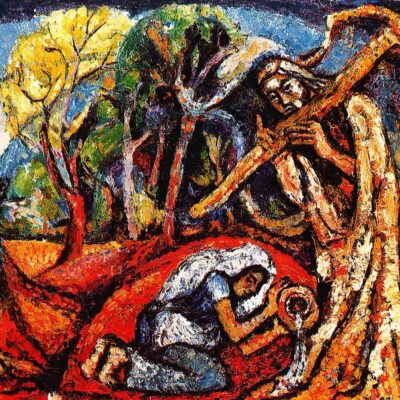Second Sunday of Easter
Last Sunday, the quiet of Lent was broken with “Alleluia’s” that encircled the entire world. The 40-day fast was broken with a feast of joy! In this 50-day season of Easter, we will be celebrating Christ’s glorious resurrection until June 8, the feast day of Pentecost, that will usher in a new season. Today is the first Sunday after Christ’s resurrection… and every year, on this first Sunday after Easter Sunday… even though we are still singing our “Alleluia’s”… the tone of our celebration shifts somewhat as we encounter a perplexed disciple named Thomas who is trying to make sense of what he is seeing, and hearing, and touching… because what he is encountering seems… simply… just too unbelievable.
Thomas is often pigeon-holed and maligned as one who doubts… as if doubting is a bad thing… as if… a rigid and unwavering faith is evidence of being a “good” Christian. Such a stance may serve well… until we meet life experiences that pierce and break our hearts… and we find ourselves perplexed and questioning our beliefs. Pain, loss, and tribulation can shake the ground beneath us. At such times, one’s once firm understanding of who God is… may begin to crack and crumble. When encountering new faith perspectives… that can challenge our cherished beliefs… we may find ourselves with a cloud of question marks swirling around us… as the ideas and beliefs we have clung to so dearly start slipping from our grasp.
The late Rachel Held Evans, author of books such as A Year of Biblical Womanhood, Searching for Sunday, and Faith Unraveled, laid out her life experience of moving from a strict evangelical upbringing to a broader and deeper understanding life and faith. In a 2011 article entitled, “Why Can’t You Just Have More Faith,” Evans reflects on the experience of waking up one morning and being unsure if there is a God… an experience that prompted questions from well-meaning friends and acquaintances who, when they learn that this seemingly faithful and unshakable woman had occasional doubts about her beliefs would ask questions like: “Why’ can’t you just have more faith?” Such questions were less-than-helpful.
Evans wrote of her friends:
“With exacerbation in their voice, they urge me to stop reading so much, stop thinking so much, and stop asking so many uncomfortable questions. My doubt, they conclude, reflects a concerted act of rebellion against God that I can start or stop at will. My doubt, they say, would vanish in an instant if I would just pay more attention to all the things God is doing in the world, if I would just have a little more faith.”
You have probably worked out the fact that I am both a woman of deep faith and a card-carrying believer in the power of healthy doubt. I believe that understanding who God is… God in the largest sense… is far beyond our ability as mere mortals to even begin to comprehend. I believe that there is no one final conclusion, no one end point, no one neat and tidy understanding. Many mystics believe that if you think you have fully grasped who God is… you have surely not understood. I do believe that Jesus came to show us… in the flesh… the love of God known in compassion, and caring, and in working for justice for all people. I believe that reading the accounts of people of faith, and accounts from people who have known doubt, can offer fresh perspectives that help us to recognize God’s presence at work in the world. Fresh perspectives and fresh ideas can, indeed, help infuse new life into our faith understanding.
Using all of our God-given senses and the mind that God created in us … can serve well… as we delve into the big questions… as we prayerfully consider who God is for is in this new moment… and as we are inspired to let go… to release… simplistic ideas that no longer serve our faith understanding. As we seek to know God better, a tight grip can actually be a hinderance. God is forever inviting us to come closer and say “yes” to the love that is forever yearning for us. We cannot move closer to God if we stay firmly planted in one place. The bottom line is, I believe, that our great God… who we can only know in part on this side of the mortal veil… is the one who calls is to life, healing, and well-being.
So what do we make of Thomas, the one who did not automatically go along with the others? …the one who questioned Jesus to his face?
One of the most notable artistic depictions… of Thomas meeting the risen Jesus in that famous locked room… was painted in 1602 by the Italian artist Caravaggio. The painting is entitled “The Incredulity of Saint Thomas”. … incredulity meaning the inability or unwillingness to believe. The question the story of Thomas poses is: By wanting tangible proof of Jesus’ resurrection, was Thomas actually wayward or stubborn… unable and/or unwilling to believe? To understanding the message of the painting… it is important to recognize that Jesus is actually guiding Thomas’ hand into his side.. as we see Thomas’ finger sink into the fleshy wound created by the real, lived experience of human pain and suffering. Jesus had known and lived the full range of human experience.
Thomas’ encounter with Jesus’ wounds may well have resonated with Thomas’ own real pain and fresh wound of grief. Jesus is patient with Thomas. Thomas had missed out on the first appearance of Jesus in the locked room that had happened a week before. The others had told Thomas what they had experienced when Jesus entered the room and said, “Peace be with you.” The other disciples had met Jesus… and they believed that he was risen from the dead. For Thomas, the reports from the other disciples would not suffice. Thomas boldly seeks proof that the Jesus he loves… the one who suffered a cruel death on Good Friday… Thomas… seeks proof that Jesus is indeed alive as the others had reported. The text does not tell us whether, or not, Thomas actually did touch the wounds. What we do know… is that… in response to Jesus’ invitation to probe further… Thomas was startled by the realization that the one he had loved and grieved was now standing in front of him… alive. Jesus’ living presence, scars and all, resonated with Thomas’ own deep experience of grief and pain… as he announces his own deep recognition… as he says: I now see that it is you! … “My Lord and my God!”
If you are a Facebook user, you can go “Episcopal Church Memes” to find humorous messages about our Episcopal flavor of faith. One meme that is meant for this Sunday shows Jesus reaching out to an awe-stricken Thomas as Jesus says: Now, now, Thomas, it’s alright. Confronting doubt can strengthen faith. 2000 years from now, you’d make a fine Episcopalian.
The great preacher Barbara Brown Taylor often confesses the power of her own doubt. In her book Leaving Church, Brown has written: “Doubt often brings me to poke at what I believe, and when it topples, I realize that it was an idol. And so doubt and disillusionment have been the divine gifts that have led me deeper into who God is.”1
…divine gifts of doubt and disillusionment…
When I preached about Thomas in 2020, right as the pandemic was picking up steam, I mused that… at a time when the world was essentially paused… at a time in which we had metaphorical space to delve into the fertile ground of our faith life… to read, to study, to pray, to look out upon world in which there was… fear and pain, and massive pandemic upheaval… at such a time… the opportunity was before us to encounter, anew, God’s ever-living presence and promise that strengthens us for whatever challenges we meet… in whatever circumstances we find ourselves.
Five years later, the full grip of the COVID pandemic may be behind us, but we find ourselves in a new time that begs us to encounter our faith afresh. In times like these… times rife with stress, conflict and uncertainty… our “yes” to God’s lifegiving presence… can only serve to strengthen as we seek to be faithful in tumultuous times. The questions are indeed with us: “Where is God in all of this?” “What does the future hold?” “Where am I in the greater scheme of things?” Amidst questions, doubts, and new experiences… this time invites our further growth and transformation. In this moment, we are being invited to use our minds, and all of our senses, to prod, to probe, to examine, and to discover anew… God’s presence… God’s love… and God’s invitation to deepen in faith …and to grow ever closer together as God’s beloved people… that we may serve in the world in Christ’s life-giving name.
The former Franciscan priest Brian Manning, who is well known for his book The Ragamuffin Gospel: Good News for the Bedraggled, Beat-Up, and Burnt Out, confesses:
“When I get honest, I admit I am a bundle of paradoxes. I believe and I doubt, I hope and get discouraged, I love and I hate, I feel bad about feeling good, I feel guilty about not feeling guilty, I am trusting and suspicious. I am honest and I still play games. Aristotle said I am a rational animal; I say I am an angel with an incredible capacity for beer.”2
Jesus comes to us in the midst of our lives… and it is with the whole of our lives, with all that we have lived, and all that we have been given… that we meet the risen Christ anew.
Jesus showed us bold, conscious love.
As Jesus invited Thomas, so he invites each one of us,
to reach out and explore…
to touch the wounds…
… and to meet the risen one…
…with our faith, doubts, and all…
as we encounter Christ in others…
in the world around us…
and in our own deep selves…
so that new life may take root and grow…
as we live into the stunning knowledge…
THAT CHRIST IS ALIVE!
And that God’s loving desire for us…
is far more than we can begin to ask for
…or imagine…
Alleluia! Christ is Risen!
1 Barbara Brown Taylor, Leaving Church, (New York: Harper Collins, 2003).
2 Brennan Manning, The Ragamuffin Gospel: Good News for the Bedraggled, Beat-Up, and Burnt Out (Sisters, OR: Multnomah Publishers, 2005), 23.





Leave a Reply